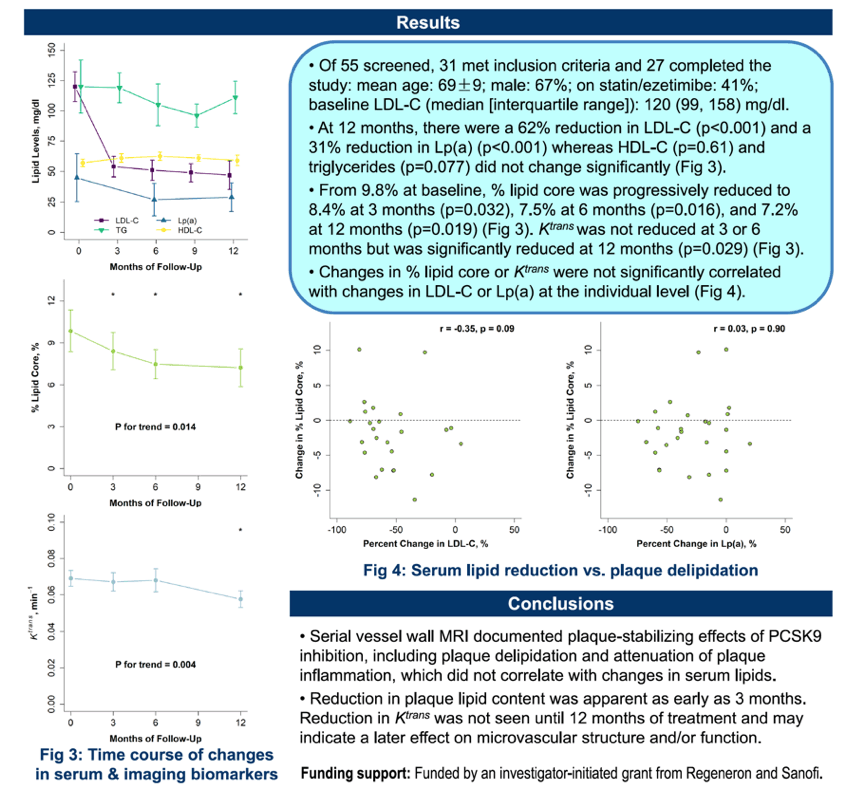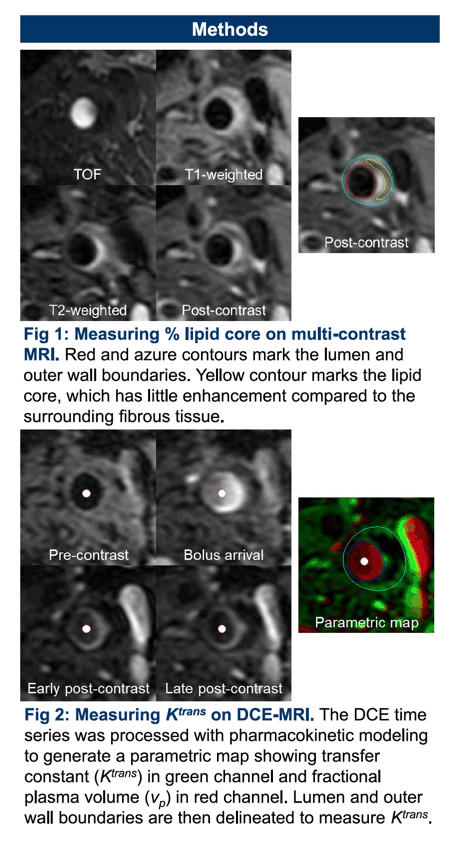| |
Effects of alirocumab on carotid plaque lipid content and
inflammation: a time course study using serial vessel wall imaging
|
| |
| |
is PCSK9 better than statin ? Jules
Download the PDF here
Session: Cardiac Magnetic Resonance ePosters
Topic: Plaque Imaging
Speaker: Assistant Professor J. Sun (Seattle, US)
Authors:
J Sun 1 , NE Lepor 2 , G Canton 1 , L Contreras 2 , DS Hippe 1 , DA Isquith 1 , N Balu 1 , I Kedan 3 , AA Simonini 3 , C Yuan 1 , TS Hatsukami 1 , XQ Zhao 1 , 1 University of Washington - Seattle - United States of America , 2 Westside Medical Associates of Los Angeles - Beverly Hills - United States of America , 3 Cedars-Sinai Smidt Heart Institute - Los Angeles - United States of America ,
Abstract
Background: PCSK9 inhibition has emerged as a potent pharmaceutical approach to lowering LDL cholesterol (LDL-C). Monoclonal anti-PCSK9 antibodies have been shown in recent clinical trials to reduce cardiovascular events in patients with atherosclerotic cardiovascular disease, but the underlying mechanisms are not fully understood. Meanwhile, circulatory inflammation markers were not reduced with PCSK9 inhibitors, thus their effects on plaque inflammation remain elusive. Vessel wall imaging with magnetic resonance (VW-MRI) has enabled serial monitoring of changes in carotid plaque lipid content and inflammation noninvasively that correlates with coronary and carotid vascular events.
Purpose: Using serial VW-MRI, we studied the effects and time course of PCSK9 inhibition with alirocumab on carotid plaque lipid content and inflammation.
Methods: Patients with LDL-C ≥70 mg/dl on ≤70 mg per week atorvastatin or an equivalent (due to statin intolerance or treating-physician discretion) and soft carotid plaque(s) identified on ultrasound underwent carotid VW-MRI. Those with confirmed lipid-rich plaque(s) on VW-MRI received alirocumab (150 mg subcutaneously every other week) and were re-scanned at 3, 6, and 12 months after treatment. Carotid VW-MRI included pre- and post-contrast images for measuring percent lipid-rich necrotic core volume (%LRNC) and dynamic contrast-enhanced images for measuring the extravasation rate of gadolinium contrast (Ktrans, reflecting tissue blood flow, endothelial surface area, and microvessel permeability), a marker of plaque inflammation. The co-primary endpoints were changes in %LRNC and Ktrans at 12 months from baseline.
Results: Of 31 patients enrolled, 27 completed the study (mean age: 69±9; male: 67%; on statins and/or ezetimibe: 41%; median LDL-C: 120 mg/dl [interquartile range: 99, 158]). Alirocumab induced a 59% reduction in LDL-C (p<0.001) on average at 3 months to a median of 54 mg/dl (interquartile range: 29, 69), which was maintained at later time points. From 9.8% at baseline, %LRNC was progressively reduced to 8.4% at 3 months, 7.5% at 6 months, and 7.2% at 12 months, representing a rapid 14% reduction (p=0.032) at 3 months and a total reduction of 20% (p=0.019) at 12 months. From 0.07±0.02 min-1 at baseline, Ktrans was not reduced at 3 or 6 months but was significantly reduced by 17% (p=0.029) at 12 months to 0.06±0.02 min-1. No significant changes in lumen or wall area were observed during the study period.
Conclusions: Serial VW-MRI documented plaque-stabilizing effects of PCSK9 inhibition with alirocumab, including plaque delipidation and attenuation of plaque inflammation. The reduction in plaque lipid content was apparent as early as 3 months. The reduction in Ktrans was not seen until 12 months of treatment and may indicate a later effect on microvascular structure and/or function. This observation represents the earliest time course of plaque morphology modification by non-statin therapy reported to date.



|
|
| |
| |
|
|
|